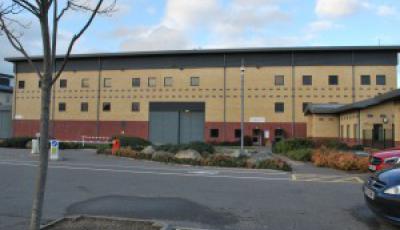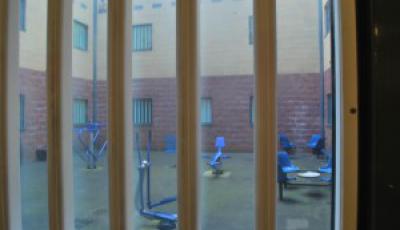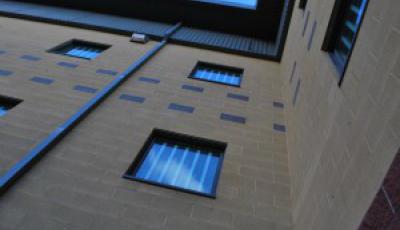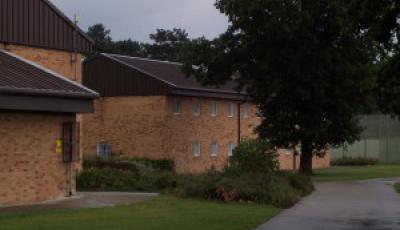Post by Mary Bosworth, Centre for Criminology, University of Oxford
As the British government holds its first public inquiry into the use and conditions of immigration detention, this post describes some of the views from inside British immigration removal centres (IRCs). Drawing on photographs as well as research and visits, it considers what the built environment and the visual horizon can tell us about the nature and purpose of this kind of confinement.
Detention centres take many forms and are located in a range of places. Some are hidden in plain sight, positioned within the urban landscape, part of the built world around us. Others are more remote. Some countries, like Australia, prefer to build them offshore, preferably on distant islands. Many throw up canvas tents as needed. Greece has been known to reuse shipping containers.
While, for the most part, social scientists are interested in the relationships and daily routines people forge, it's evident in custodial institutions that the built environment plays an important role in people's experiences. How a building is designed, what it smells like, the soundscape, how air circulates, the amount of light allowed in, and the size of its rooms will inevitably affect people. Perhaps less obviously what those who are confined see when they look outside is also important.

In the UK, views from detention vary considerably. Upon arrival in Colnbrook or Harmondsworth IRCs, men (and the few women) detained might primarily see over the high fences to one another.

Once within the walls, external views differ depending on which unit a person's room is situated. The outdoor space associated with the short-term holding facility includes an outdoor gym, while the IRC's staff garden, to which detainees on C-unit can see from their windows, offers more visual variety.


In each outdoor area, however, even the sky feels curtailed.

At Dungavel IRC, in Scotland, the view is bucolic―if you overlook the razor wire. In front, green fields as far as you can see. Behind, the nineteenth century former hunting lodge of the Duke of Hamilton.
Unlike the more securitised centres in the south of England, the so-called 'sterile zone' in Dungavel, into which trucks arrive and from which they depart, delivering and removing their human cargo, is marked out merely by a red painted line on the ground; a symbolic internal barrier, a point that cannot be crossed.
Tinsley House and Brook House IRCs, built so close to the runway at Gatwick that the rumble of take off is audible, have little of note to see. Like Colnbrook, their views are mainly internal, as most external windows are frosted. In Yarl’s Wood IRC, at the back of a remote industrial estate near Bedford and surrounded by forest, the women (and handful of men) might catch a glimpse of a rabbit, not just outside the fence but within it too.
At Dover IRC, an English Heritage site perched atop the Western Heights in an area that's been fortified since Roman times, the predominant view is of the English Channel and, on a clear day, glimpses of the northern coast of France. For those with south-facing rooms, looking beyond the fences and razor wire, the sea beckons. Others look over the paved yards making up the centre's interior spaces. The view of the ocean can be a mixed blessing, one man revealed; while he admired its beauty, his view of it was a constant reminder of his confinement. Originally from a seaside town, this was the first time he had been able to see the ocean, without being free to go in it.
Those incarcerated for their immigration status, it seemed, did not deserve such niceties.

Some years earlier, photographer Melanie Friend revealed in a series of images of empty spaces in detention, the banality of control evident in their design. In her work, the eerily depopulated spaces raise questions about the nature and purpose of these sites, asking the viewer to think critically about them.
On a recent visit to Campsfield House IRC, the view from detention revealed the expansionist nature of border control and its everyday indignities. Following considerable renovation, Campsfield House now includes a new outdoor space with picnic tables, a gazebo, and an all-weather football pitch.

The field beyond, pleasingly green in the spring and summer months at least, has been earmarked for further expansion. It's to the right, however, that one of the more unsettling views of detention can be glimpsed; a plane’s fuselage sits on the ground, just over the wire fence, in the adjacent prison service training centre. A new tool for the prison service, the fuselage will be used to instruct private escort officers on the correct methods of control and restraint on a plane.

Like the runways adjacent to a number of IRCs, the fuselage serves as a blunt reminder of where detainees are heading. Like the barbed wire that surrounds them, it demonstrates the potential violence of state power too, as this new form of training is brought in to prevent any more deaths during enforced removals. In the proximity of this site to the IRC, and its visibility to those detained―many of whom will inevitably be fearful of their return and its execution―the government forces those behind bars to confront, each day, the symbol of their power to remove. It’s unlikely that the location of the fuselage in plain sight was deliberate. Yet, in its visibility to those locked up, and its invisibility to citizens living nearby, this particular view from detention captures neatly the casual dehumanisation of detainees and the need to include their views as well as their voices in our research.
Thoughts on this topic? Post a comment here or on our Facebook page. You can also tweet us.
__________
How to cite this blog post (Harvard style):
Bosworth M (2014) Views from Detention. Available at: http://bordercriminologies.law.ox.ac.uk/views-from-detention (Accessed [date]).
Share:








